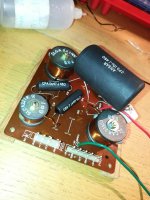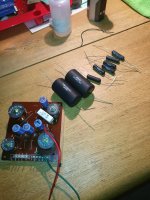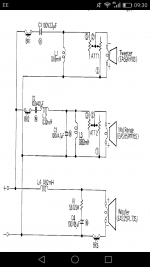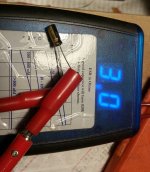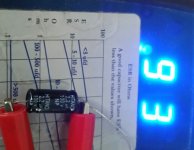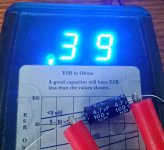Hi There! This is my first post. Brief introduction i have a pretty basic and limited knowledge of HiFi equipment and a fairly basic understanding of electronics (always keen to learn though).
Recently went out and bought an Onyko A9010 Amp and a set of Q Acoustics 3020 only to be left underwhelmed by the speakers performance i started remember my love for older HiFi gear and headed straight to Ebay, Google and Gumtree to see what i could find, a few days later i had a pair of very nice coniditon Technics SB-X3 speakers for peanuts. Got them home and plugged them in and on the whole was fairly impressed with their sound.
Not being satisfied i got the tinkering urge and started to pull apart check the internal speaker connections, crossover, and to give them a general spruce up. I them started reading into the capacitor replacement for the crossover and that generally electrolytic caps are bad past 20 years or so. So having never modified a crossover ever i started googling furiously for the types of capacitors to be hit with a minefield of options, prices and types. The SB-X3 crossover features 4 NPE's, 4 Inductors and one Wire Wound resistor in series with the woofer cap. From my week of googling i opted for some Ansar Supersound polypropylene as its suggested they are vastly superior to any electrolytic capacitor in an audio path and they sat at a reasonable price point.
I have just soldered them on today, expecting to be greeted with an uplift in treble brightness and clarity (seems to be the main enhancement NPE vs poly), but only to hear a muddy ruined speaker.
Hours and hours of head scratching and checking soldering i cant figure it out guys. With the new capacitors in place the Mid cone and tweeter's output are effectively reduced by 50-75% over NPE's. More research and reading into ESR issues on Polys vs NPE's i then decided to add an inline wirewound resistor in series with the cap, i tried 0.1, 0.22, 0.5, 1.0 Ohm and none made a discernable difference. THe woofer output seems unacfected and the volume seems inline with normal on the Poly cap, although people seem to leave NPE's for the woofer and use Polys for the tweeter i just decided to renew them all. I have bypassed the speakers mid/tweeter attenuators and that also made no difference.
Where am i going wrong guys? I don't have the knowledge to know what to probe or how to trouble shoot futher. I want to make it work.
I Have attached some pictures of the Crossover. The link to this manual shows the crossover schematic and PCB layout. Thanks for any help you an offer!
Technics SB-X3 - Linear Phase Speaker System - HiFi Engine
TECHNICS SB-X3 - Service Manual Immediate Download
Recently went out and bought an Onyko A9010 Amp and a set of Q Acoustics 3020 only to be left underwhelmed by the speakers performance i started remember my love for older HiFi gear and headed straight to Ebay, Google and Gumtree to see what i could find, a few days later i had a pair of very nice coniditon Technics SB-X3 speakers for peanuts. Got them home and plugged them in and on the whole was fairly impressed with their sound.
Not being satisfied i got the tinkering urge and started to pull apart check the internal speaker connections, crossover, and to give them a general spruce up. I them started reading into the capacitor replacement for the crossover and that generally electrolytic caps are bad past 20 years or so. So having never modified a crossover ever i started googling furiously for the types of capacitors to be hit with a minefield of options, prices and types. The SB-X3 crossover features 4 NPE's, 4 Inductors and one Wire Wound resistor in series with the woofer cap. From my week of googling i opted for some Ansar Supersound polypropylene as its suggested they are vastly superior to any electrolytic capacitor in an audio path and they sat at a reasonable price point.
I have just soldered them on today, expecting to be greeted with an uplift in treble brightness and clarity (seems to be the main enhancement NPE vs poly), but only to hear a muddy ruined speaker.
Hours and hours of head scratching and checking soldering i cant figure it out guys. With the new capacitors in place the Mid cone and tweeter's output are effectively reduced by 50-75% over NPE's. More research and reading into ESR issues on Polys vs NPE's i then decided to add an inline wirewound resistor in series with the cap, i tried 0.1, 0.22, 0.5, 1.0 Ohm and none made a discernable difference. THe woofer output seems unacfected and the volume seems inline with normal on the Poly cap, although people seem to leave NPE's for the woofer and use Polys for the tweeter i just decided to renew them all. I have bypassed the speakers mid/tweeter attenuators and that also made no difference.
Where am i going wrong guys? I don't have the knowledge to know what to probe or how to trouble shoot futher. I want to make it work.
I Have attached some pictures of the Crossover. The link to this manual shows the crossover schematic and PCB layout. Thanks for any help you an offer!
Technics SB-X3 - Linear Phase Speaker System - HiFi Engine
TECHNICS SB-X3 - Service Manual Immediate Download
Attachments
Never heard of Ansar caps, no idea where they sit in the quality universe.
I would try something else, maybe even just some plain old Nichicon Muse bipolar electrolytics. (They should have similar electrical characteristics to the originals)
Clarity Cap is one that I also like and find not too expensive.
I would try something else, maybe even just some plain old Nichicon Muse bipolar electrolytics. (They should have similar electrical characteristics to the originals)
Clarity Cap is one that I also like and find not too expensive.
It sounds like you have lost your treble, which is not something I would expect when replacing an electro with a polyprop. It is true that the reduced ESR can cause problems, though that will usually be peaking at particular frequencies.
Two things I note. There appear to be lpads and also protection circuits. I would check that the lpads are functioning correctly (ie you are getting continuity through to your tweeters) and also follow the reset procedure for the protection circuit.
Actually, scrap that. I've just had a close look at your caps. I think you have got 0.22uF and 0.47uf instead of 2.2uF and 4.7uF. That will definitely cause the problems you are describing!
Tony.
Two things I note. There appear to be lpads and also protection circuits. I would check that the lpads are functioning correctly (ie you are getting continuity through to your tweeters) and also follow the reset procedure for the protection circuit.
Actually, scrap that. I've just had a close look at your caps. I think you have got 0.22uF and 0.47uf instead of 2.2uF and 4.7uF. That will definitely cause the problems you are describing!
Tony.
I may be able to help a smidge.
I just upgraded my SB-X50's with caps and coils from Erse Audio.
I went PP on everything except the big one, I went with Muse BP on that one.
It made a HUGE improvement for me!.
I would suggest checking your solder joints and maybe relocating some of the really bulky pieces off board like I did.
I just upgraded my SB-X50's with caps and coils from Erse Audio.
I went PP on everything except the big one, I went with Muse BP on that one.
It made a HUGE improvement for me!.
I would suggest checking your solder joints and maybe relocating some of the really bulky pieces off board like I did.
Never heard of Ansar caps, no idea where they sit in the quality universe.
I would try something else, maybe even just some plain old Nichicon Muse bipolar electrolytics. (They should have similar electrical characteristics to the originals)
Clarity Cap is one that I also like and find not too expensive.
Hi Kevin, I believe Ansar are pretty tried and tested, their quality is not the issue of my problems.
I grabbed some cheap new bipolar caps with the same values, these capacitors were cheap and in size comparison to the original they are about quarter of the size. HOWEVER, they sound just fine! But... i'm the sort of person that likes to push the n'th degree (like a lot of people on this forum no doubt), hence not wanting to have to make do with inferior NPE's, so still want to make this work.
It sounds like you have lost your treble, which is not something I would expect when replacing an electro with a polyprop. It is true that the reduced ESR can cause problems, though that will usually be peaking at particular frequencies.
Two things I note. There appear to be lpads and also protection circuits. I would check that the lpads are functioning correctly (ie you are getting continuity through to your tweeters) and also follow the reset procedure for the protection circuit.
Actually, scrap that. I've just had a close look at your caps. I think you have got 0.22uF and 0.47uf instead of 2.2uF and 4.7uF. That will definitely cause the problems you are describing!
Tony.
Hi Tony, had head of Lpads mentioned in a few places but honestly had no idea what they are. The tweeter definately has continuity i can hear it doing its thing its just .... quiet, almost whisper quite and thats with the amp volume turned up 50%+
Im off to check resistor values, keen eye i would not have spotted that. I'll check my receipet order vs what i have and report back! Thanks
I think you missed Tony's point which is the crux of the matter.
You have installed 0.47uF capacitors in place of the original 4.7uF and 0.22uF in place of the original 2.2uF caps. (I looked a second time to be sure)
Your capacitors have 1/10th the required capacitance.
Note that 0u47 = 0.47uF
You have installed 0.47uF capacitors in place of the original 4.7uF and 0.22uF in place of the original 2.2uF caps. (I looked a second time to be sure)
Your capacitors have 1/10th the required capacitance.
Note that 0u47 = 0.47uF
I've just checked the order, you guys nailed it i cocked the order up as you've said (0.22uF instead of 2.2uF and 0.47uF instead of 4.7uF).
Will purchase correct and report back. Thanks for spotting guys i wouldnt have noticed that for a while!
Einric i will check your thread out, they are great speakers arent they?
Will purchase correct and report back. Thanks for spotting guys i wouldnt have noticed that for a while!
Einric i will check your thread out, they are great speakers arent they?
I absolutely cannot believe how good a 40yr old pair of speakers sound.
I am beyond satisfied with their performance.
My F4 works very well with them.
I am beyond satisfied with their performance.
My F4 works very well with them.
OK, once you have the correct values you should get a very different result!! 🙂 You also have the resistors now to try different series resistance if there are any niggling issues as well (note that you would most likley only need it on the shut caps not the 2.2 in series with the tweeter, unless the treble gets a bit hot. 🙂
Tony.
Tony.
Last edited:
Cool. Another question i see people mentioning the use of 'bypass caps'with very small values. Could you explain their benefit and how they fit in the circuit? Should i be using one?
It's a common but erroneous term. When you parallel two caps you create a cap with the combined values. Nothing is being bypassed. It was common when fancy caps were relatively even more expensive than today. Wishful people would add tiny fancy caps that they could afford to whatever they were using. The change in capacitance was so small that they did not have to resize the main cap to keep the same transfer function. There was the wish that the 'special' properties of the more expensive caps would dominate the sound.
Last edited:
Not so much of a tiny additional value but more of an effect on ESR I would think.
PP caps are already low ESR, the lower the value cap the lower the ESR generally.
Sticking a .01uF cap in parallel with a 2.2uF or 4.7uF would cause a negligible change in value.
HOWEVER the ESR of a .01uF film foil cap is vanishingly low.
Now think about the to capacitors ESR as resistors.
Two resistors in parallel will have a combined resistance of less than the lowest resistor value.
POOF, you have just created a 4.7uF PP capacitor with an ESR lower than a .01uF FF Capacitor.
That is where the value of "bypassing" is.
IMHO
PP caps are already low ESR, the lower the value cap the lower the ESR generally.
Sticking a .01uF cap in parallel with a 2.2uF or 4.7uF would cause a negligible change in value.
HOWEVER the ESR of a .01uF film foil cap is vanishingly low.
Now think about the to capacitors ESR as resistors.
Two resistors in parallel will have a combined resistance of less than the lowest resistor value.
POOF, you have just created a 4.7uF PP capacitor with an ESR lower than a .01uF FF Capacitor.
That is where the value of "bypassing" is.
IMHO
I'd suggest you measure the esr before imagining things. You are not paralleling two resistors, but two capacitors which have resistance. The esr of even an electrolytic tiny cap is tiny itself.
Actually the ESR of a small value electrolytic can be into the 10's of ohms. Electrolitics ESR goes up the smaller the value of the cap is.
I just measured a nichicon FG 1uf 50V and ESR was around 3 ohms (was flicking between 2.9 and 3.0)
Tony.
I just measured a nichicon FG 1uf 50V and ESR was around 3 ohms (was flicking between 2.9 and 3.0)
Tony.
Attachments
Last edited:
Re 40 yr old speakers: the technology was already mature by the seventies, and the next step had to do with enclosure matching and crossover refinement. Exotic diaphragm shapes and materials have come and gone, leaving paper still dominant, though beryllium is taking over the high end. Now we have neodymium magnets and digital filters, which I don't discount, but the good old stuff is still good.
3 ohms?!?
3 ohms?!?
Last edited:
In a lot of cross-over network design the ESR of electrolytic capacitors is a critical element in controlling the Q of the network transfer function. I learned this the hard way with a pair of AR LS-58s which I more or less ruined through replacement of all of the caps with "better" pp caps. The solution I know now is to add some resistance in series with the cap.
Note that this a common cost cutting ploy used by many mid market hifi speaker manufacturers from the 1960s onwards. (Two of my former employers did this with both inductors and capacitors used in their XO designs.)
Note that this a common cost cutting ploy used by many mid market hifi speaker manufacturers from the 1960s onwards. (Two of my former employers did this with both inductors and capacitors used in their XO designs.)
I went digging and also found some bipolar caps of the values the OP has.
a 1uF bP was 2.4 ohms (so close to the FG value).
But the 2.2 was 0.93 ohms and the 4.7 0.39 ohms. The ESR drops fairly rapidly as the capacitance goes up.
Tony.
a 1uF bP was 2.4 ohms (so close to the FG value).
But the 2.2 was 0.93 ohms and the 4.7 0.39 ohms. The ESR drops fairly rapidly as the capacitance goes up.
Tony.
Attachments
Last edited:
- Home
- Loudspeakers
- Multi-Way
- Vintage Crossover Polypropylene upgrade...sounds awful! (help)
